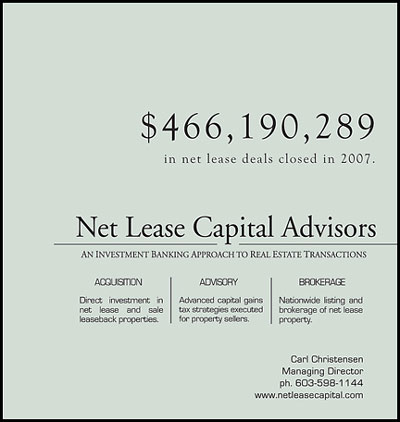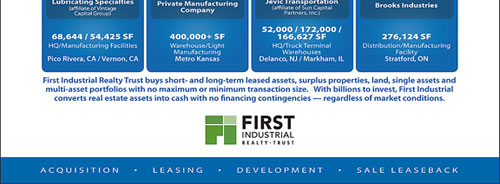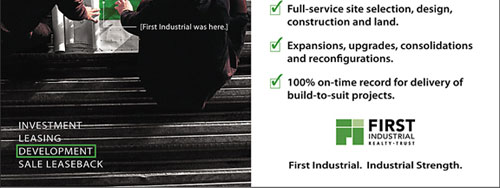
SALE/LEASEBACK TRANSACTIONS
strategies in tough times
CHRISTIE ALEXANDER, Principal,
NAI Realvest, Orlando, FL
n times of economic uncertainty, cash is a preferred asset because it can provide a hedge against the unknown.
Commercial real estate properties owned by operating companies are assets that can be turned into cash. This can be done by selling real estate that is not needed and selling and then leasing back real estate that is needed. Corporate leased real estate assets are sought-after properties by investors and institutions.
of sale/leaseback transactions globally in 2007,
and market experts expect the trend to continue.
Better yet, such transactions can typically be done in a relatively short time frame.
“The majority of corporate America is not in the real estate business, and the extent to which corporate America can monetize its real estate and redeploy those assets, in theory, into higher return opportunities in their primary businesses, then it makes good economic sense to do so,” said Bill Pollert, President of CapLease, Inc., a New York-based REIT.
“In today’s financial environment where the debt markets are essentially shut down, companies that may not be investment grade are finding it challenging and expensive to raise capital,” Pollert said, noting that such companies can gain a significant economic advantage by doing sale/leasebacks to raise capital rather than going to the debt markets.
Real Capital Analytics tracked $56 billion of sale/leaseback transactions globally in 2007, and market experts expect the trend to continue.
“I do expect sale/leaseback activity to pick up in the second half of 2008,” said Bob Micera, Senior Vice President and National Head of Net Lease Investments for First Industrial Realty Trust, Inc. “Especially as we’ve seen in past cycles in debt constrained markets, companies look to monetize their real estate as an alternative form of capital, and sale/leasebacks tend to become a more attractive financing vehicle for corporations.”
Sale/leaseback transactions can be used for nearly any property type. They are common for bank facilities, which can be as large as Banco Santander’s agreement with a consortium led by Propinvest for the $2.8 billion sale and 40-year leaseback of its Madrid headquarters. In the U.S., the two SunTrust Bank Portfolios acquired by Inland Real Estate Acquisitions were valued at approximately $736 million for 433 properties totaling 2.2 million sq. ft. in nine states. A bank transaction may be as small as a $4-million, two bank branch outparcel sale/leaseback transaction in Orlando completed last year by NAI Realvest and NAI Capital.
Industrial properties are targeted by First Industrial Realty Trust throughout the U.S., and the REIT has recently formed a new fund joint venture with the California State Teachers’ Retirement System (CalSTRS) for European operations.
Restaurant properties also lend themselves well to this type of transaction. An example is a Carl’s Jr. franchisee using a sale/leaseback campaign with the goal of growing the business and paying down debt. Andy Bogardus, partner in the Leased Investment Group at NAI BT Commercial in San Francisco, said the company has completed nearly 20 sale/leaseback transactions over the past three years. As a result, the restaurant operator has been successful in more than doubling its number of restaurants.
A portfolio of 100-percent leased Pennsylvania medical office buildings is under agreement in the $27-million range, negotiated by Jason Sourbeer and Erik Gainor at NAI CIR.
The state of the capital markets and the economy, national and local, will affect an asset’s value. How the deal is structured by the operating company has a significant impact on the ultimate sales price, however. Here is what a company can do to create and then capitalize on the asset’s value:
• Structure the lease to be at least 10 years in length; a longer lease term typically enhances value.
• The lease rate should be at market and include modest increases, 2 percent to 3 percent per year, for example. Above market rates will make financing the purchase difficult to impossible.
• The leases should be triple net with the tenant responsible for all operating expenses.
• The tenant also may want to assume all capital expenses for longer leases, structure and roof, for example. This will increase the value of the property.
• The seller should use a qualified and experienced corporate services advisor, such as a commercial real estate investment broker, to assist in developing strategies, structuring the lease, determining value, identifying likely buyers, preparing the sales brochure, marketing the property and assisting in the transaction and closing process.
• The time from decision to closing is relatively short in current market conditions. Transactions can be done in 90 to 180 days. Even shorter periods are possible. The seller’s decision and negotiating skills impact time to close.
Once the transaction is complete, the sale has significant advantages to the operating company:
• Non-liquid assets are converted into cash.
• Capital assets are removed from the balance sheet and replaced by cash.
• Debt on the balance sheet that was associated with the real estate is removed.
• Debt equity ratios are improved.
• The lease, on the other hand, then goes on the balance sheet as a footnote.
• The lease payments are tax deductible to the new tenant.
There can be drawbacks:
• There may be tax liabilities to the seller for the sale.
• Sellers lose some flexibility as to the future use of the real estate.
can also be incorporated into a
growing corporation’s strategy to provide
consistent non-operating income.
• The seller could lose the opportunity to occupy the building at the end of the lease, but options can address this issue.
• If the seller wants to vacate early, they will have to sublease the property.
• Any future appreciation of value accrues to the buyer.
The buyers of occupied corporate real estate as investments have significant advantages too:
• Predictable long-term stream of cash flow.
• Low management required for the investment.
• The tenant likes the property and the location and so likely will not vacate at the end of the term.
• The value of the property can appreciate, say roughly at the rate of the lease increases.
• The annual increases in the rent rate, along with the possibility of appreciation, are a hedge against inflation.
• The property provides some tax shelter through depreciation and other write-offs.
• Positive leverage is typically possible to enhance the return.
Variations on the lease strategies can also be incorporated into a growing corporation’s strategy to provide consistent non-operating income. This can be a significant contribution to the bottom line for growing companies.
A company can self-develop a new facility, sell the property, and then lease it back. This will require short-term corporate debt.
The company can hire a competent general contractor or construction manager to oversee their developments, then sell the properties, and lease them back. Again, construction debt would be necessary.
An operating company can joint venture with a developer to execute the sale/leaseback strategy with the debt on the developer’s balance sheet. The profits would then be split between the company and the developer after the sale/leaseback transaction is completed.
If your company has a short-term need for liquidity in the long run to yield non-operating income, consider using sale/leaseback transactions as a strategy to adopt and execute to achieve either or both of these goals. Sale/leaseback strategies are especially appropriate for the current volatile times.
Site Selection Online – The magazine of Corporate Real Estate Strategy and Area Economic Development.
©2008 Conway Data, Inc. All rights reserved. SiteNet data is from many sources and not warranted to be accurate or current.






